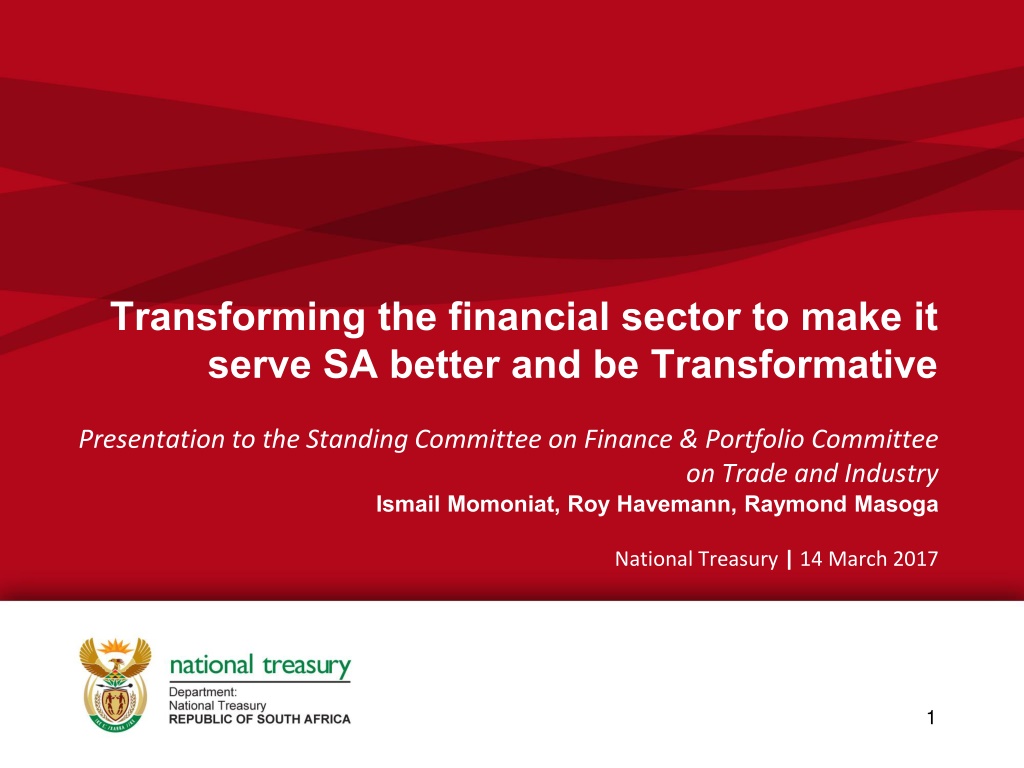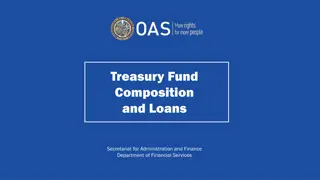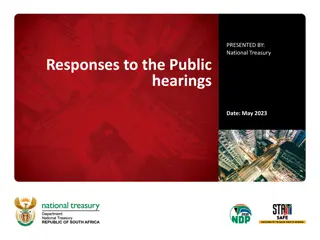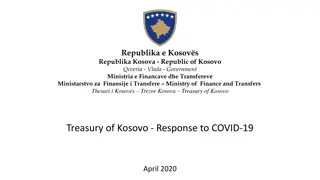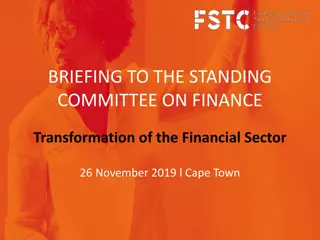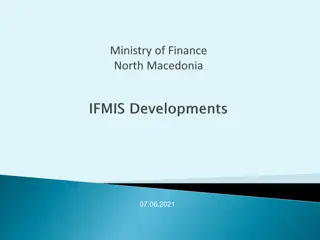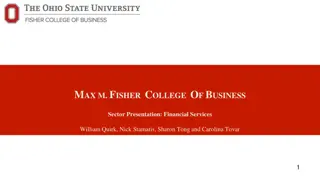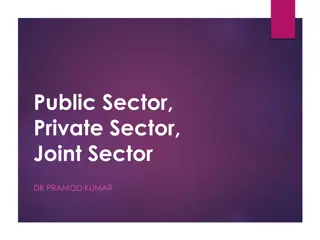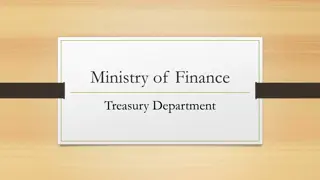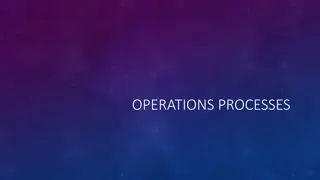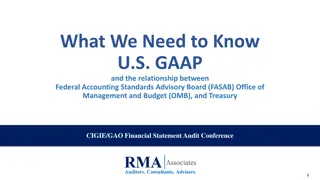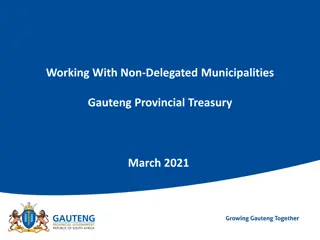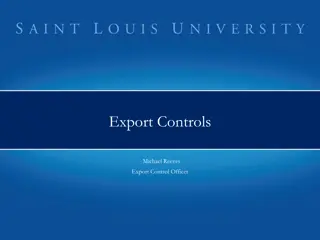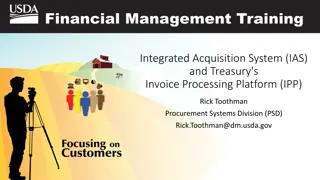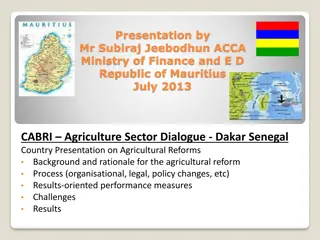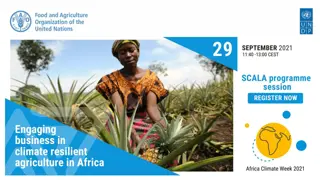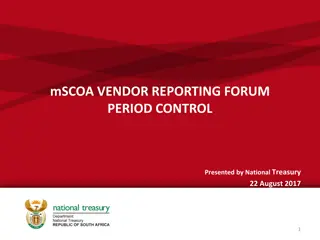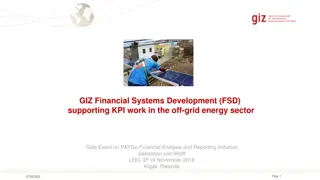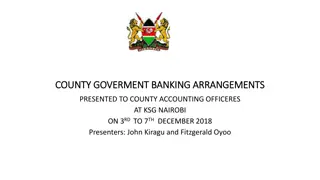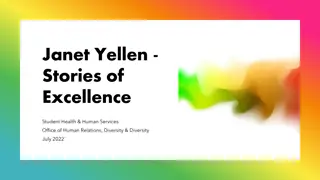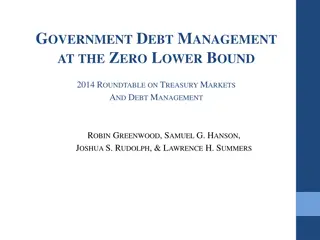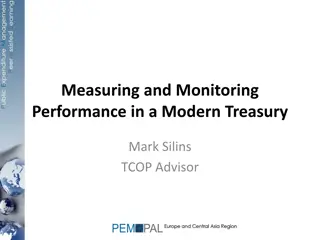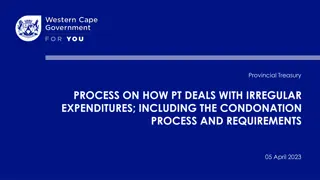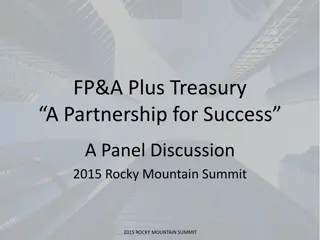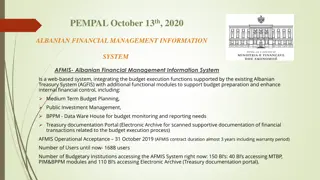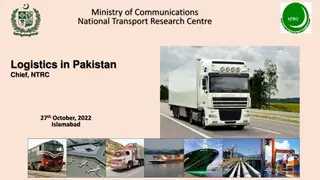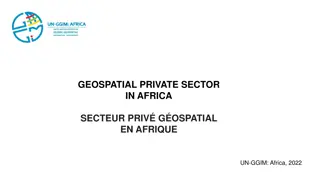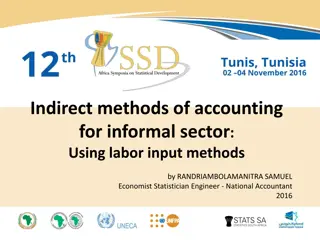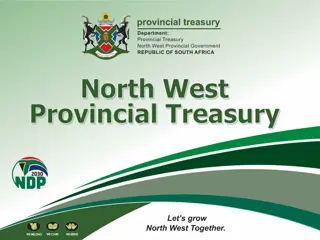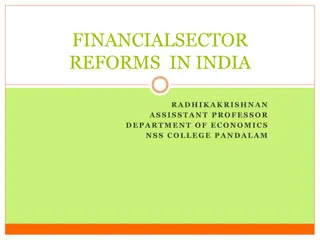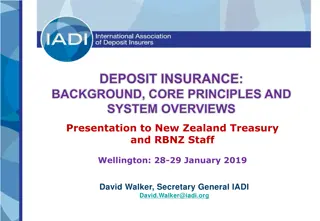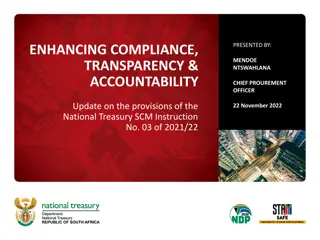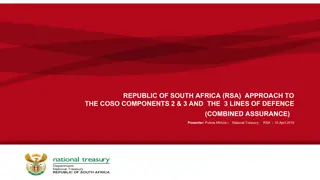Transforming the Financial Sector for Better Service: National Treasury Presentation
National Treasury presented insights on transforming the financial sector to serve South Africa better through promoting economic transformation, reducing inequality, and implementing higher standards for transformation. The discussion focused on the challenges, achievements, and lessons learned, emphasizing the need for mass-based and sustainable changes to benefit all South Africans.
Download Presentation

Please find below an Image/Link to download the presentation.
The content on the website is provided AS IS for your information and personal use only. It may not be sold, licensed, or shared on other websites without obtaining consent from the author. Download presentation by click this link. If you encounter any issues during the download, it is possible that the publisher has removed the file from their server.
E N D
Presentation Transcript
Transforming the financial sector to make it serve SA better and be Transformative Presentation to the Standing Committee on Finance & Portfolio Committee on Trade and Industry Ismail Momoniat, Roy Havemann, Raymond Masoga National Treasury | 14 March 2017 1
National Treasury welcomes the transformation debate National Treasury welcomes the public hearings on transformation in the financial sector Opportunity to deal with the real issues and ask: why have current transformation initiatives not been as successful as required, after 20 years of freedom? Economic transformation, de-racialisation and reducing inequality critical for political stability Priority for Treasury is mass-based and sustainable transformation rather than for a few Some tax incentives to promote empowerment and ESOPs The financial sector must work for ALL South Africans Need to generate more asset wealth for more South Africans Annexure F in 2017 Budget Review provides NT perspective We are here to listen, and will respond once all the submissions made 2 2
Some key questions about the transformation process What do we mean by transformation? What have we achieved and what do we want to achieve? How far have we gone? What are the obstacles and challenges we have faced? What are the lessons that we have learnt? 3 3
Financial sector needs HIGHER standards for transformation The financial sector acts as an intermediary Mobilises savings Allocates credit Provides payment services Facilitates trade In South African context, access to finance and financial services are key to achieve economic and social transformation Funds controlled by the financial sector ultimately belong to customers, and financial firms are merely custodians of other peoples money. Hence govt has to regulate: Safety and soundness of financial firms (prudential regulation), That firms treat their customers fairly (market conduct regulation). Financial stability risks, to reduce bailing out banks by taxpayers (fiscus) (taxpayers) as 2008 GFC 4 4
Financial sector needs HIGHER standards for transformation Potential for conflict between above objectives, and lessons learnt from 2008 Global Financial Crisis (GFC), led to the adoption of the Twin Peaks regulatory framework. Meaningful transformation of the financial sector is not merely a question of ownership of financial firms, but to how the sector supports real economic activity? What services are provided to consumers? (Access/Inclusion, lower charges, more appropriate products) Who owns the firms that manage the assets? How sensitive are they to our country s needs and challenges? How are the assets in the system put to use? (Procurement, empowerment financing, socio-economic development) Who decides how those assets are invested / put to use? (Management control, employment equity and skills development) 5 5
Financial sector comprises banks and non-banks South Africa s financial sector is large and sophisticated, consisting of banking and non-banks (insurers, pension funds, unit trusts, CIS) Financial sector assets make up three times GDP The ratio exceeds most emerging market economies Banking assets comprise over 100% of GDP Non-banks account for about two thirds of financial assets, also unusually large for an emerging market Pension funds assets of 110% of GDP, almost equal to banking Long-term insurers (mostly life) hold most of insurance assets of 64% of GDP, with only a small share for short-term insurers (nonlife) Unit trusts or CISs, the fastest growing segment in the financial sector, hold assets of nearly 50% of GDP. 6 6
Structure of the financial sector Number of companies Assets of sector 10 locally controlled 55 6 foreign controlled 36 Foreign bank reps 3 mutual Banks R4.87 trillion* Long-term Insurers (life) Short-term Insurers (non-life) 82 R 2.58 trillion* 99 R 0.12 trillion* Pension Funds 5150 (incl. GEPF and official funds) R 4.04 trillion* Collective Investment Schemes 1284 R1.953 trillion** Asset Managers 130 Manage on behalf of sector * End 2015 ** end 2014 Further detail in Annexure 7 7
The financial sector connects savers to borrowers and facilitates economic growth (1) Banks Insurance companies Pension Funds etc. Asset Management Companies Savers 1) Businesses 2) Households 3) Government Borrowers 1) Businesses 2) Households 3) Government Financial Markets (debt / equity) Investment banks Brokerage firms 8 8
The financial sector connects savers to borrowers and facilitates economic growth (2) CIS Government employees Insurance Official pensions Private pensions R1.9 tn R1.9 tn R2.8 tn R1.8 tn R2.8 tn Financial Intermediation 10% 20% 16% 53% 1% Cash deposits to banks Gov. Bonds (incl. local gov and public enterprises) R1.9 tn Corporate bonds and loans Equities Fixed property R0.9 tn R1.5 tn R5 tn R0.09 tn 9 9
What do we mean by transformation in financial sector? A de-racialised financial sector reflected by: Ownership and management more reflective of black South Africans Enterprise development and procurement of services involving black households and businesses Access and inclusion of black households & effective usage of financial services Promoting asset wealth of black households Providing better access to funding for small businesses Developmental and competitive objectives Funding infrastructure and capital projects that promote growth and jobs Ensuring a more competitive and less concentrated financial sector Ensuring impact of transformation is transformative, meaning a financial sector that works for all South Africans, helping South Africans to save, borrow, insure, transact 10 10
Budget Speech A new perspective on economic transformation is required The litmus test of our programmes must be what they do to create jobs, eliminate poverty and narrow the inequality gap. Transformation must be mass-based and sustainable, benefiting the most disadvantaged South Africans through the creation of new assets, capabilities and opportunities to build livelihoods We have to mobilise both private and public investment in social and economic infrastructure, new technologies and new activities that help build a modern and diversified economy. We must continue to confront cartels and collusion robustly and provide new opportunities for access to markets Transformation must achieve a more balanced structure of ownership and control in our economy. Transformation must build self-reliance of South Africans, reject the dependence on debt and protect our fiscal sovereignty. Transformation must result in an economy that belongs to all, black and white, where the legacy of race domination is no longer visible. Budget Speech 2017, Minister Pravin Gordhan 11 11
A holistic response is required To truly transform the financial sector in SA, a significantly higher savings rate be achieved. This can only happen when the economy grows in an inclusive manner. Together with broad structural reforms in the economy, I.e more inclusive growth and broad-based benefits (higher per-capital growth - GDP growth exceeding population growth), SA savings levels will increase and create space for growth by domestic financial institutions. With well functioning regulatory oversight by all key stakeholders, greater influence on the "orientation" of financial institutions towards "financial transformation" can be exercised, as the gap between domestic savings and investment narrows, and reliance on foreign savings/presence of foreign financial institutions in SA economy diminishes. 12 12
Do FSC targets give effect to transformation objectives? Key question is whether the FSC gives effect to transformation objectives? Are the targets set in FSC the right targets to ensure transformation? Is the FSC succeeding in transforming the financial sector or not? Are targets ambitious enough? What could be refined? Breakdown within FSC btw 2008 and 2012 has affected the process of setting appropriate targets Examples of more specific or refined targets Unsecured credit targets has resulted in household over-indebtedness, and needs to be refined to focus on more productive use of credit Procurement in short-term insurance could be more inclusive Asset management industry needs to transform more than any other subsector in the financial sector Financial Sector Summit proposed by NEDLAC provides a basis to review FSC 13 13
How can we also ensure that current BEE codes are sharpened to give effect to mass-based transformation? Similar review of targets in BEE codes also necessary Are the current BEE codes sufficient to cover all transformation objectives? Current BEE regulations do not cover financial inclusion and access How do the codes encourage asset wealth (free of debt!)? Do BEE codes do enough to promote inclusive growth and mass-based transformation? BEE codes need to protect (and in fact benefit) members of retirement funds who lose share every time there is a new BEE deal 2008 Global Financial Crisis categorises major banks and insurers as SIFIs (systemically important financial institutions) and imposes higher capital requirements BEE Codes need to take better account of regulatory requirements Is the current BEE funding model used by many major companies sustainable? Is it really sustainable to expect dividends to grow more rapidly than loans? What happens with low growth and rising interest rates? 14 14
Structural challenges to ownership transformation in listed companies How do we ensure that the black ownership is less geared, and rising, and more broad based (including ESOPs for employees)? Direct ownership is limited to around 30% for most JSE companies 10% black owned, so 20% non-black owned Data does not say how much of the 10% is borrowed or geared Lack of savings in SA means that we rely on foreign savings to invest in or buy shares in SA domiciled companies, so foreign ownership around 37% (can go up to 50% of more when growth is higher, or for inward listed companies) Most ownership is institutional, so domestic institutional closer to 30% BEE codes need to ensure that they do not make black members of retirement funds pay for new BEE deals Multi-national companies may be less flexible on ownership shares, consider JVs and non-ownership targets e.g. enterprise development, exco/senior management, staff profile (China example) 15 15
Policy framework for the financial sector National Treasury strongly supports interventions to the financial sector to serve South Africa better Policy proposals are contained in A safer financial sector to serve South Africa better mutually reinforcing Access to financial services Combating financial crime Financial Stability Consumer Protection Enforcement agencies to lead Treasury to lead SARB to lead FSB and NCR to lead Support to Co-ops and dedicated banks, including Postbank; microinsurance Investigating and prosecuting abuses New market conduct regulator, Conduct of Financial Institutions Act FSOC Continued work with international peers From access to usage
NT multi-pronged approach to transformation Market Conduct Market Development Financial Inclusion FSC commitments Ownership Reduced Fees Dedicated banks Deepening financial inclusion for individuals Management control and employment equity More appropriate products Postbank Procurement Enterprise development Extending access to credit for SMEs Cooperative banks The right to complain, ombud system Access to Fin. Services Micro- Insurance Skills development Financial Literacy Financial inclusion as transformation tool Empowerment financing SMMEs CSI and socio- economic development 17 17
Factors to consider in transforming financial sector Regulatory obligations, Twin Peaks brings flexibility Capital requirements applicable to banks & insurers Fit and proper / qualification requirements Anti-money laundering KYC compliance requirements Require a proportionate, risk based and enabling regulatory framework for smaller firms Non-regulatory obligations as financial institutions are custodians of other peoples money Gate-keepers asset consultants who direct investment to established businesses Insurers not in sufficient control of procurement spend outsourced to brokers e.g. separate panels for motor body repairers Enforcement of BEE codes and FSC targets: stronger role of the regulators at the coal-face? 18 18
Why are bank BEE deals different? Banks are regulated INTRUSIVELY, INTENSELY and EFFECTIVELY Banks are different from both other sectors of the economy and with rest of financial sector A significant shareholder cannot buy banking shares by borrowing from another bank (need UNENCUMBERED CAPITAL) Banks get their capital from equity (shareholders) to safeguard against losses What banks lend out they obtain from depositors and bond holders Banks and State are interconnected, as they are biggest buyers of sovereign bonds, which they need for their regulated capital (Basel 3) Greek crisis due to sovereign downgrade caused banking risk EU banking risk caused sovereign risks and country downgrades Failure of a major bank has domino effect and causes other banks to fail, causing depression/recession in the economy, and massive loss of jobs (SIFIs) 19 19
How are bank BEE deals different? cont Traditional BEE funding model is to fund a BEE deal through future dividends which fund a company loan against such dividends A significant shareholder (or more than 15%) ideally needs to fund such shares with hard cash, that is not borrowed If bank fails, shareholders lose their capital and have to put in more capital to maintain their share. In addition, bond holders who lend to a bank so that the bank can on lend to others lose their loans (junior, senior debt) Both banking and insurance have regulated capital, and this must be taken into account for ownership targets in BEE deals Taking these factors into account requires innovative solutions to support black ownership in the financial sector 20 20
Options to accelerate transformation of the financial sector Use current state owned institutions to address market failings E.g. expand the risks covered by SASRIA Government support for a large new black owned co. New /merger of smaller banks? Broaden ownership of current state owned institutions E.g. give Postbank shares to previously disadvantaged individuals Introduction of additional State owned financial institutions But case not clear State-led solutions Market-orientated solutions Using Government as a large customer to promote transformation E.g. PIC has an incubation programme and directs funds to emerging asset managers Introduction of more black-owned participants Address regulatory and non-regulatory barriers Enforced transformation of current market participants Rejuvenate the FSC process Strengthen current FSC requirements But problems discussed above 21 21
Proposed market development framework for banks SA has developed a tiered banking system to allow for new entrants with proportional regulatory requirements: The banking sector remains highly concentrated how to bring in new black- owned contester? Universal commercial bank. (R250m capital) To facilitate more competition NT has introduced increased tiers to allow for greater participation Dedicated Bank (proposed, R50m capital) Mutual Bank (R10m capital) Volkskas Bank began as a co-operative bank in 1934 and became a commercial bank in 1941 and forms basis of ABSA. Co-op Bank (R1m capital and 200 members) Current example is VBS Bank. Extend role of CBDA? Role of microinsurers? 22 22
Financial Inclusion Policy proposals Pillar 1 - Deepening financial inclusion for individuals Most South Africans already financially served, focus on usage and quality Pillar 2 - Extending access to SMEs Finance for SMMEs important for growth, but severely constrained Pillar 3 - Financial inclusion as transformation tool Diversification of the financial sector Projects: Increasing financial inclusion impact of social grant distribution Improving savings through a low-value savings scheme Improving beneficial use of acquired bank accounts, appropriate insurance products Improving the appropriate use of credit Improving housing finance Recourse mechanisms, client onboarding, financial education Projects: Promote access to credit Improve credit infrastructure Credit information sharing Data-based credit scoring Shift away from collateral based lending to data-based lending Partial credit guarantee schemes Movable asset register Projects: Use of agents in the provision of financial services Role of state vs private banks Role of cooperative development banks/dedicated banks Promoting youth development and women Enabling smaller community based providers Funeral parlours Burial societies Stokvels Other Appropriate insurance products for SMEs The use of a bank account and payment services 23 23
Conclusion Financial sector must do more to transform and be transformative Some sub-sectors like asset management need to do more than others as they have made little progress in transforming More robust engagement is required within the Financial Sector Charter Council to refine and sharpen targets BEE Codes need to take account of Regulatory obligations and specific challenges like SIFIs Mass-based transformation objectives like access and inclusion Debt-free asset wealth for the majority of SA Treasury in listening mode, and interested in submissions made as they will assist in identifying expectations on transformation of the financial sector Financial Sector Summit provides a valuable opportunity to review FSC and its targets, and ensure they are more relevant . 24 24
Thank you 25
